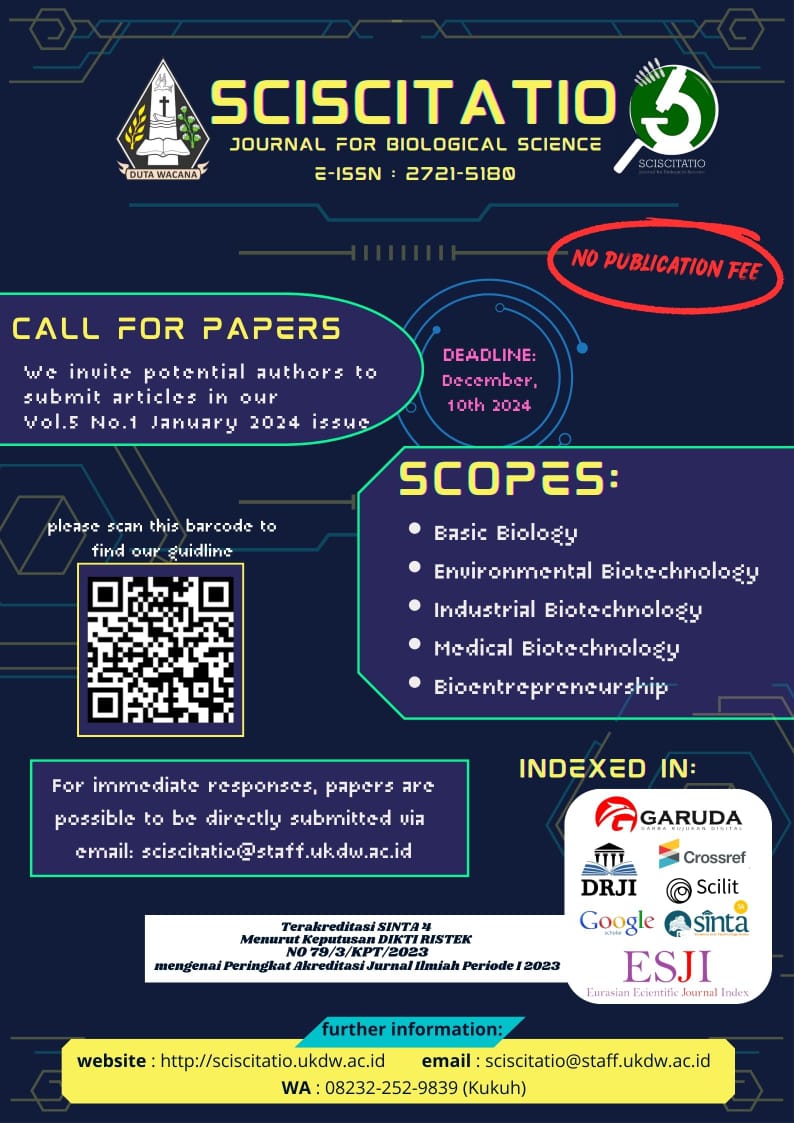Detection and Identification of Microbial Contaminant in Bakery Products in Yogyakarta City, Indonesia
DOI:
https://doi.org/10.21460/sciscitatio.2020.11.13Keywords:
bakery product, microbial contaminant, API Staph, PCR, moldAbstract
Bread has been chosen as an alternative food because of its availability. In Indonesia, consumption
of breads is increased due to the change of diet pattern into packed and ready-made meals. Therefore, it is
important to raise the awareness of bakery products quality. The purpose of this study was to detect and
identify the microbial contaminant in bakery products in Yogyakarta City, Indonesia. Bacterial colonies
from expired bakery products were isolated into pure isolate then confirmed by API Staph and Polymerase
Chain Reaction (PCR) method. The results showed there were five kinds of gram-positive bacteria. Isolated
bacteria identified by API were Bacillus cereus (52.8%), Bacillus subtilis (97.7%), Staphylococcus aureus (97.7%),
Staphylococcus epidermidis (97,9%) and Staphylococcus saprophyticus (72,2% and 61,8%).
References
J Science and Tech, 5(11), pp. 727–731.
Badan Standardisasi Nasional (BSN). (2009).SNI 7388, Batas Maksimum Cemaran Mikrobia dalam Pangan. Jakarta.
Capita, R., Alonso-Calleja, C., Moreno, B., & Garcia-Fernandez, M. D. (2001). Assessment of baird-parker agar as screening test for determination of Staphylococcus aureus in poultry meat, Journal of Microbiology, 39(4), pp. 321–325.
Colozza, D & Avendano, M. (2019). Urbanisation, dietary change and traditional food practices in Indonesia: A longitudinal analysis, Social Science and Medicine. Elsevier, 233(February), pp. 103–112.
Edwards, W. P. (2007). The science of bakery products. The Royal Society of Chemistry. Cambridge, UK.
Gautam, A. K & Bhadauria, R. (2012). Characterization of Aspergillus species associated with commercially stored triphala powder, Characterization of Aspergillus species associated with commercially stored triphala powder, 11(104), pp. 16814–16823.
Johnson, W. M., Tyler, S. D., Ewan, E. P., Ashton, F. E., Pollard, D. R., & Rozee, K. R. (1991). Detection of genes for enterotoxins, exfoliative toxins and toxic shock syndrome toxin 1 in Staphylococcus aureus by the polymerase chain reaction, Journal of Clinical Microbiology, 29(3), pp. 426–430.
Kateete, D. P., Kimani, C. N., Katabazi, F. A., Okeng, A., Okee. M. S., Nanteza, A., Joloba, M. L., & Najjuka. F. C. (2010). Identification of Staphylococcus aureus: DNase and Mannitol salt agar improve the efficiency of the tube coagulase test, Annals of Clinical Microbiology and Antimicrobials, 9, pp. 1–7.
Kim, B. J., Lee, K. H., Park, B. N., Kim, S. J., Bai, G. H., Kim, S. J., & Kook, Y. H. (2001). Differentiation of mycobacterial species by PCR-restriction analysis of DNA (342
base pairs) of the RNA polymerase gene (rpoB), Journal of Clinical Microbiology, 39(6), pp. 2102–2109.
Navi, S. S., Bandyopadhyay, R., Hall, A. J., & Bramel-Cox, P. J. (1999). A pictorial guide for the identification of mold fungi on Sorghum Grain Hall, International
Crops Research Institute for Semi Arid Tropics, 1999.
O’Connor, A. (2012). An overview of the role of bread in the UK diet, Nutrition Bulletin, 37(3), pp. 193–212.
Oliver, J. D. (2005). The viable but nonculturable state in bacteria, Journal of Microbiology, 43(2), pp. 93–100.
Silva, D. M., Batista, L. R., Rezende, E. F., Fungaro, M. H. P., Sartori, D., & Alves, E. (2011). Identification of fungi of the genus Aspergillus section nigri using polyphasic taxonomy, Brazilian Journal of Microbiology, 42(2), pp. 761–773.
Soleimani, M., Hosseini, H., Pilevar, Z., Mehdizadeh, M., & Carlin, F. (2018). Prevalence, molecular identification and characterization of Bacillus cereus
isolated from beef burgers, Journal of Food Safety, 38(1), pp. 1–8.
Stenfors, A. L. P., Fagerlund, A., & Granum, P. E. (2008). From soil to gut: Bacillus cereus and its food poisoning toxins, FEMS Microbiology Reviews, 32(4), pp.
579–606.
Tallent, S. M., Kotewicz, K. M., Strain, E. A., & Bennet, R. W. (2012). Efficient isolation and identification of Bacillus cereus group, Journal of AOAC International,
95(2), pp. 446–451.
Vo, T. H., Le, N. H., Cao, T. T. D., Nuorti, J. P., & Minh, N. N. T. (2014). An outbreak of food-borne salmonellosis linked to a bread takeaway shop in Ben Tre
City, Vietnam, International Journal of Infectious Diseases. International Society for Infectious Diseases, 26(2014), pp. 128–131.


